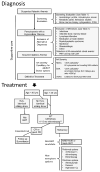Diagnosis and Treatment of Aplastic Anemia
- PMID: 29143887
- PMCID: PMC5804354
- DOI: 10.1007/s11864-017-0511-z
Diagnosis and Treatment of Aplastic Anemia
Abstract
Acquired aplastic anemia (AA) is a rare, life-threatening bone marrow failure (BMF) disorder that affects patients of all ages and is caused by lymphocyte destruction of early hematopoietic cells. Diagnosis of AA requires a comprehensive approach with prompt evaluation for inherited and secondary causes of bone marrow aplasia, while providing aggressive supportive care. The choice of frontline therapy is determined by a number of factors including AA severity, age of the patient, donor availability, and access to optimal therapies. For newly diagnosed severe aplastic anemia, bone marrow transplant should be pursued in all pediatric patients and in younger adult patients when a matched sibling donor is available. Frontline therapy in older adult patients and in all patients lacking a matched sibling donor involves immunosuppressive therapy (IST) with horse antithymocyte globulin and cyclosporine A. Recent improvements in upfront therapy include encouraging results with closely matched unrelated donor transplants in younger patients and the emerging benefits of eltrombopag combined with initial IST, with randomized studies underway. In the refractory setting, several therapeutic options exist, with improving outcomes of matched unrelated donor and haploidentical bone marrow transplantation as well as the addition of eltrombopag to the non-transplant AA armamentarium. With the recent appreciation of frequent clonal hematopoiesis in AA patients and with the growing use of next-generation sequencing in the clinic, utmost caution should be exercised in interpreting the significance of somatic mutations in AA. Future longitudinal studies of large numbers of patients are needed to determine the prognostic significance of somatic mutations and to guide optimal surveillance and treatment approaches to prevent long-term clonal complications.
Keywords: Antithymocyte globulin; Aplastic anemia; Bone marrow failure; Bone marrow transplant; Clonal hematopoiesis; Cyclosporine A; Eltrombopag; Immunosuppressive therapy.
Figures

References
-
- Desmond R, Townsley DM, Dumitriu B, Olnes MJ, Scheinberg P, Bevans M, et al. Eltrombopag restores trilineage hematopoiesis in refractory severe aplastic anemia that can be sustained on discontinuation of drug. Blood. 2014;123(12):1818–25. doi:10.1182/blood-2013-10-534743. A follow-up of a phase 2 study of eltrombopag monotherapy in patients with refractory SAA showing an overall response of 40%, with a subset of patients achieving trilineage hematopoietic responses. - PMC - PubMed
-
- Townsley DM, Scheinberg P, Winkler T, Desmond R, Dumitriu B, Rios O, et al. Eltrombopag Added to Standard Immunosuppression for Aplastic Anemia. N Engl J Med. 2017;376(16):1540–50. doi:10.1056/NEJMoa1613878. A prospective phase 1–2 study of immunosuppressive therapy plus eltrombopag in newly-diagnosed SAA showing that addition of eltrombopag improves hematologic response as compared to historical IST controls. - PMC - PubMed
-
- Dufour C, Veys P, Carraro E, Bhatnagar N, Pillon M, Wynn R, et al. Similar outcome of upfront-unrelated and matched sibling stem cell transplantation in idiopathic paediatric aplastic anaemia. A study on behalf of the UK Paediatric BMT Working Party, Paediatric Diseases Working Party and Severe Aplastic Anaemia Working Party of EBMT. Br J Haematol. 2015;171(4):585–94. doi:10.1111/bjh.13614. A retrospective analysis of 29 consecutive children who underwent unrelated donor transplantation with Fludarabine/Cyclophosphamide/Alemtuzumab (FCC) conditioning in an upfront setting, which showed outcomes similar to historical controls treated with matched sibling donor transplantation and superior to IST and to unrelated donor transplant after IST failure, suggesting that front-line therapy with unrelated donor BMT may be considered in selected pediatric patients without a matched sibling donor. - PubMed
Publication types
MeSH terms
Substances
Grants and funding
LinkOut - more resources
Full Text Sources
Other Literature Sources
Medical
Molecular Biology Databases

